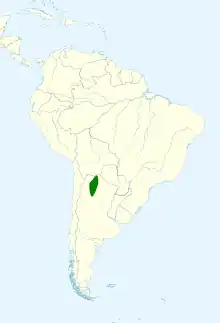| Yungas sparrow | |
|---|---|
 | |
| From Salta, Argentina | |
| Scientific classification | |
| Domain: | Eukaryota |
| Kingdom: | Animalia |
| Phylum: | Chordata |
| Class: | Aves |
| Order: | Passeriformes |
| Family: | Passerellidae |
| Genus: | Rhynchospiza |
| Species: | R. dabbenei |
| Binomial name | |
| Rhynchospiza dabbenei (Hellmayr, 1912) | |
 | |
| Synonyms | |
| |
The Yungas sparrow (Rhynchospiza dabbenei) is a species of bird in the family Passerellidae endemic to the Southern Andean Yungas of southeastern Bolivia and northwestern Argentina. It was formerly considered a subspecies of what was then called the stripe-capped sparrow (R. strigiceps).[1]
Taxonomy and systematics
The Yungas sparrow was previously classified as a subspecies of Rhynchospiza strigiceps, which was at that time called the stripe-capped sparrow. Before that, Rhynchospiza had been subsumed into genus Aimophila. A 2009 publication restored the genus Rhynchospiza and a 2019 publication split R. dabbenei from R. strigiceps.[2][3] Based on the 2019 publication, in June 2020 the South American Classification Committee (SACC) of the American Ornithological Society (AOS) accepted R. dabbenei as the Yungas sparrow and renamed R. strigiceps Chaco sparrow. The International Ornithological Congress (IOC) followed suit in January 2021.[4][1]
Description
The Yungas sparrow is larger than its former "parent" R. strigiceps. Its upper parts are brown with darker streaks and varying amounts of rust and gray. It is pale gray below blending to buff on the flanks and in the vent area. The head is gray with chestnut crown and postocular stripes, black lores, and a white moustachial stripe.[5][3]
Distribution and habitat
The Yungas sparrow is a year-round resident of the Southern Andean Yungas, a narrow region on the eastern side of the Andes in southwestern Bolivia and northwestern Argentina. The area is characterized by a subtropical highland climate and evergreen forest.[3][5]
Vocalization
The Yungas sparrow's song is a series of chirps that contrast with the complex trills of the Chaco sparrow.[3]
Status
The IUCN has not evaluated the Yungas sparrow.
References
- 1 2 Gill, F.; Donsker, D.; Rasmussen, P. (January 2021). "IOC World Bird List (v 11.1)". Retrieved January 14, 2021.
- ↑ DaCosta, J. M., G. M. Spellman, P. Escalante, and J. Klicka. 2009. A molecular systematic revision of two historically problematic songbird clades: Aimophila and Pipilo. J. Avian Biology 40:206-216
- 1 2 3 4 Areta, Juan I.; Depino, Emiliano A.; Salvador, Sergio A.; Cardiff, Steven W.; Epperly, Kevin; Holzmann, Ingrid (2019-10-01). "Species limits and biogeography of Rhynchospiza sparrows". Journal of Ornithology. 160 (4): 973–991. doi:10.1007/s10336-019-01695-2. ISSN 2193-7206. S2CID 199473089.
- ↑ Remsen, J. V., Jr., J. I. Areta, E. Bonaccorso, S. Claramunt, A. Jaramillo, D. F. Lane, J. F. Pacheco, M. B. Robbins, F. G. Stiles, and K. J. Zimmer. Version 19 January 2021. A classification of the bird species of South America. American Ornithological Society. http://www.museum.lsu.edu/~Remsen/SACCBaseline.htm retrieved January 19, 2021
- 1 2 Jaramillo, A. (2020). Stripe-capped Sparrow (Rhynchospiza strigiceps), version 1.0. In Birds of the World (J. del Hoyo, A. Elliott, J. Sargatal, D. A. Christie, and E. de Juana, Editors). Cornell Lab of Ornithology, Ithaca, NY, USA. https://doi.org/10.2173/bow.stcspa1.01 retrieved April 23, 2021